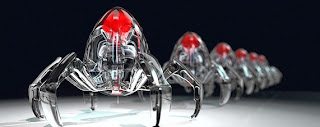Making molecules that can do our bidding
 A while back Susan Blackmore delivered a fascinating TED lecture in which she suggests that humanity has spawned a new kind of meme (a unit of cultural ideas, symbols or practices, which can be transmitted from one mind to another through writing, speech, gestures, rituals or other imitable phenomena),called a "teme", which spreads itself via technology -- and uses/manipulates humans to keep itself alive.
A while back Susan Blackmore delivered a fascinating TED lecture in which she suggests that humanity has spawned a new kind of meme (a unit of cultural ideas, symbols or practices, which can be transmitted from one mind to another through writing, speech, gestures, rituals or other imitable phenomena),called a "teme", which spreads itself via technology -- and uses/manipulates humans to keep itself alive.Is this the brave new world we were warned about? (GW)
They Walk. They Work. New DNA Robots Strut Their Stuff
By Robert Lee Hotz
Wall Street Journal
May 13, 2010
For the first time, microscopic robots made from DNA molecules can walk, follow instructions and work together to assemble simple products on an atomic-scale assembly line, mimicking the machinery of living cells, two independent research teams announced Wednesday.
These experimental devices, described in the journal Nature, are advances in DNA nanotechnology, in which bioengineers are using the molecules of the genetic code as nuts, bolts, girders and other building materials, on a scale measured in billionths of a meter. The effort, which combines synthetic chemistry, enzymology, structural nanotechnology and computer science, takes advantage of the unique physical properties of DNA molecules to assemble shapes according to predictable chemical rules.
Until now, such experiments had yielded molecular novelties, from smiley faces so small that a billion can fit in a teaspoon to molecule-size boxes with lids that can be opened, closed and locked with a DNA key.
These new construction projects bring researchers a step closer to a time when, at least in theory, scientists might be able to build test-tube factories that churn out self-assembling computers, rare chemical compounds or autonomous medical robots able to cruise the human bloodstream.
In one of the projects, a pioneering research group based at New York University built the prototype of a molecular factory in which mobile DNA robots assembled gold particles in eight different ways, in response to chemical commands. The second team, led by a biochemist at Columbia University, programmed a DNA robot that could start, stop, turn and move.
"Here we can see some glimmers of things to come," said Harvard University biophysicist William Shih, who was not involved in the projects. "This is exciting."
The DNA work is a small part of a nearly $9 billion research-and-development effort world-wide, according to the private Project on Emerging Nanotechnologies, which tracks environmental and health concerns arising from the new technology. So far, new nano-materials have been incorporated in hundreds of electronic, cosmetic, automotive and medical products made by 485 companies in 24 countries. But none involve these exotic man-made DNA objects.
Both research groups tinkered with creations called DNA walkers—mobile DNA molecules, about 100,000 times smaller than the diameter of a human hair, that have three or more legs made of a string of genetic enzymes. Each leg moves forward based on its chemical attraction to sequences of biochemicals laid down, like stepping stones, in front of it.
These robots are so small that the researchers program their actions by encoding commands in the world around them. They follow chemical cues programmed into the ground on which they walk.
In the first project, a team of scientists led by biochemist Milan Stojanovic at Columbia built a molecular robot that moved on its own along a track of chemical instructions—the DNA equivalent of the punched paper tape used to control automated machine tools.
Once programmed, the robot required no further human intervention, the researchers reported. It could turn, move in a straight line or follow a complex curve and then stop, all essentially on its own initiative. They documented its progress with an atomic force microscope as it strode along a path 100 nanometers long, about 30 times further than earlier DNA walkers could manage.
"In the future, this could be used as a molecular machine that could bind to a cell surface, maybe carry a cargo and release something," said biochemist Hao Yan at the Biodesign Institute at Arizona State University, one of 12 researchers at four universities involved in the project.
At New York University, scientists led by chemist Nadrian Seeman took that idea a step further. They combined a programmable DNA track and a squad of mobile robotic walkers with a set of independently controlled molecular forklifts that can deliver parts on command. The result was a functioning nano-factory, the researchers reported.
"An industrial assembly line includes a factory, workers and a conveyor system," said Dr. Seeman. "We have emulated each of those features using DNA components."
By triggering different DNA sequences, the researchers could order up to eight different combinations in their experimental product line.
"It is very significant," said California Institute of Technology bioengineer Paul Rothemund, who was not involved in either project. "This is the kind of thing that happens in living cells all the time."
Biochemist Lloyd Smith at the University of Wisconsin in Madison cautioned that it may be a decade or more before DNA nanotechnology leads to any useful applications.
"This is a field to watch," Dr. Smith said. "But this is still fundamental research to find out what ability mankind has to make molecules that can do its bidding."

0 Comments:
Post a Comment
<< Home